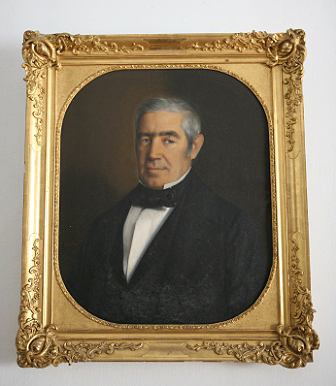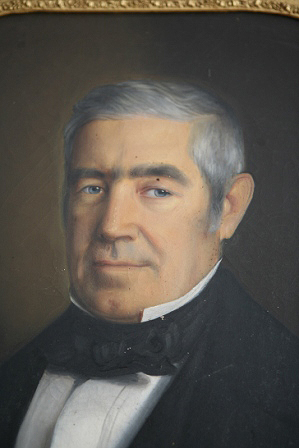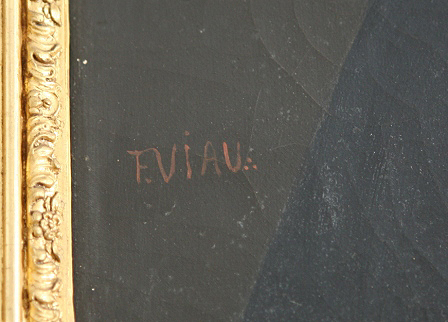The piece of the month of November 2012
PORTRAIT SIGNED BY FORTUNÉ VIAU OF A MERCHANT FROM NAVARRE (C. 1850)
Eduardo Morales Solchaga
Chairof Navarrese Heritage and Art
In its original location is preserved a beautiful canvas invoice portraying a businessman of the first half of the nineteenth century, Pablo de Irazoqui. On a practically neutral background stands, slightly tilted and looking towards the viewer, the bust effigy of the aforementioned character, already in adulthood, who appears dressed in the typical clothing of those years: coat with wide lapels, black vest, white shirt with open collar and black bow tie.

Portrait of Don Pablo de Irazoqui
Pablo Esteban de Irazoqui e Irazoqui was the first-born son of Juan Francisco Irazoqui Sanjuanena and Josefa Antonia Irazoqui Pedrorena. He must have been born accidentally at the end of the XVIII century in Castrojeriz, during a family visit , since his uncle had married there in 1775, starting another family branch which is not necessary to insist on. Pablo was the eldest of four siblings: Juan José, José Esteban - a priest - and Magdalena, who never married.
His economic rise probably came from commerce, since in the first years of the XIX century he appears referenced as a businessman in Bilbao, dedicated to merchandise, with which he made a huge fortune. There he married Nicolasa Regina Lapeira (1826), who came from a wealthy family of the town, to which perhaps contributed the fact that three years earlier he had been named universal heir of his uncle, Miguel Esteban de Irazoqui, who died in Lima, where he had increased his estate thanks to a brilliant military degree program .
In any case, by 1831 he was living in Vera de Bidasoa, managing his business through agents in Madrid and Bayonne. There he rebuilt from 1832 the family house, close to the parish of San Esteban, sparing no expense expense . His wife must have died nearby, so in 1842 he remarried María Benita Echenique Garmendia, a native of Urdax, with whom he had four children: María (1843), Primitiva (1846), Antero (1849) and Irene (1850).
He died in 1854, after a serious illness that had prostrated him since the previous year, leaving the house and fortune in the hands of his wife until his first-born son came of age. The will and subsequent inventory of assets attest to his values, religiosity and charity, as well as his immense fortune. As far as real estate is concerned, there are almost a dozen houses in Vera de Bidasoa and its surroundings, as well as lands of work and ferns, of great importance to make up fertilizer for cultivation. As for his assets, without going into details, he left the family more than 200,000 reales de vellón in cash and deposits, as well as 80,000 francs in Bayonne. The fact that he worked with important agents such as Ignacio García in Bayonne, and Ventura Cerrajería and Eladio Gallo in Madrid, speaks for itself of his importance as a merchant.
Some of the testamentary mandates give evidence of his humanity, leaving 1,000 reales for his maid, 2,000 for the restoration of the damaged parish of San Esteban de Vera, another 2,000 to distribute among the poor of the town, 1,000 reales for the Casa de Misericordia of Bilbao and another 2,000 reales for the Hospital of Pamplona. He spared no expense for his funeral and subsequent masses, including those that should be sung at report for his first wife, of whom he kept a great memory. In the local cemetery he erected a considerable marble pantheon, in the form of a neoclassical shrine, whose pediment shows an hourglass with wings, in allusion to the fleetingness of life.

Portrait of Don Pablo de Irazoqui. Detail
The author of the composition is Fortuné Viau (1812 - 1889), a French painter born in Chinon, whose life trajectory is well known, thanks to the preservation of his diary staff. From a young age, he was fascinated by drawing, initially training with Professor Cléry, son of Louis XVI's chamber teaching assistant , with whom he gradually specialized in the genre of portraiture, reaching a certain perfection Degree . After many difficulties, he went to Paris, where he was fascinated by the great art galleries and used certain subterfuges to gain admission to the School of Fine Arts to continue his pictorial training .
In spite of all this, he did not obtain the desired success and returned to his native city in 1831, where his neighbors and relatives were impressed with his incipient work, obtaining the patronage of the city council itself, which paid for his subsequent training . From the second half of that decade, he became an itinerant painter and portraitist, which would lead him to reside in towns as diverse as Villeneuve-le-Roi, Paris, Argentan, La Rochelle, Bordeaux, Agen, Toulouse, Mouy, Moulins, Montluçon, Saintes, Jonzac, Nortron and Périgueux, where he painted a large number of portraits, although he also painted genre, religious and landscape paintings. After 1848 the diary does not reflect any more information about his pictorial work, although he certainly continued to practice his profession. Perhaps in some of those localities he portrayed Pablo de Irazoqui, since his businesses in the neighboring country were known, or he would do it in Vera de Bidasoa itself, since the present heirs of the painter have well-founded suspicions that he moved along the Pyrenean border. Whatever the case may be, it must have been executed in the middle of the century, close to the death of the portrayed, which occurred, as has been mentioned, in 1854.
Apart from all this and at staff, he belonged to Freemasonry, which probably contributed to the expansion of his clientele and mobility. In fact, among his testamentary clauses, written in Blois in 1873, he makes it clear that he intended a civil burial, and that his Masonic ornaments should accompany him in his coffin. His status as a Freemason is also reflected in the signature of the canvas studied here "F. VIAU*" which incorporates the famous equilateral triangle, associated with multiple Masonic meanings, and undoubtedly sample of the pride he felt for belonging to the aforementioned association.

Portrait of Don Pablo de Irazoqui. signature de Fortuné Viau
SOURCES:
-file General de Navarra. Notarial Protocols. Vera de Bidasoa.
-file of the Senate of Madrid. transcript HIS-0231-01.
-file Diocesan of Pamplona. Sacramental Records.
-file Historical - Ecclesiastical of Vizcaya. Sacramental Records.
-Diary of Fortuné Viau (1808 - 1852) [unpublished].
